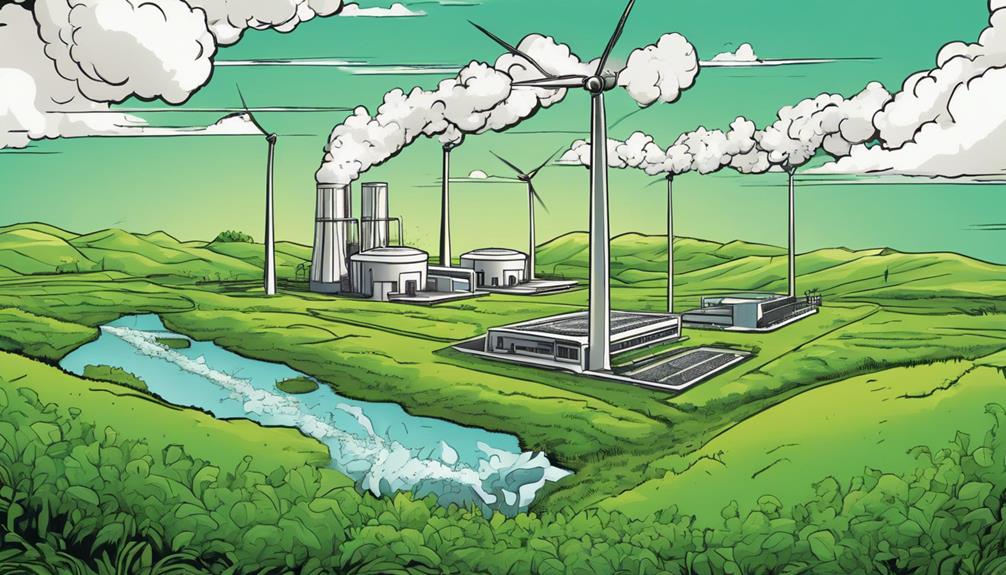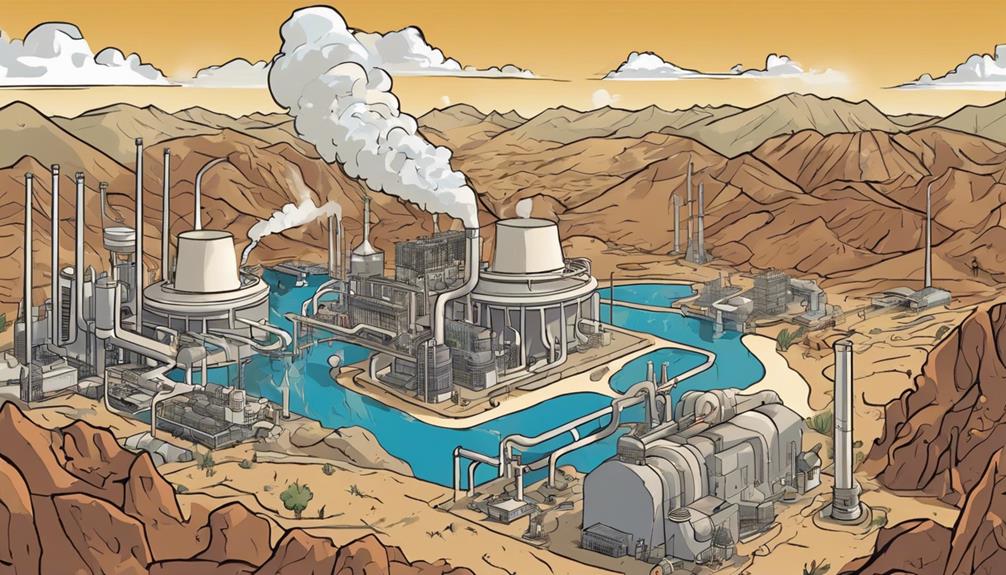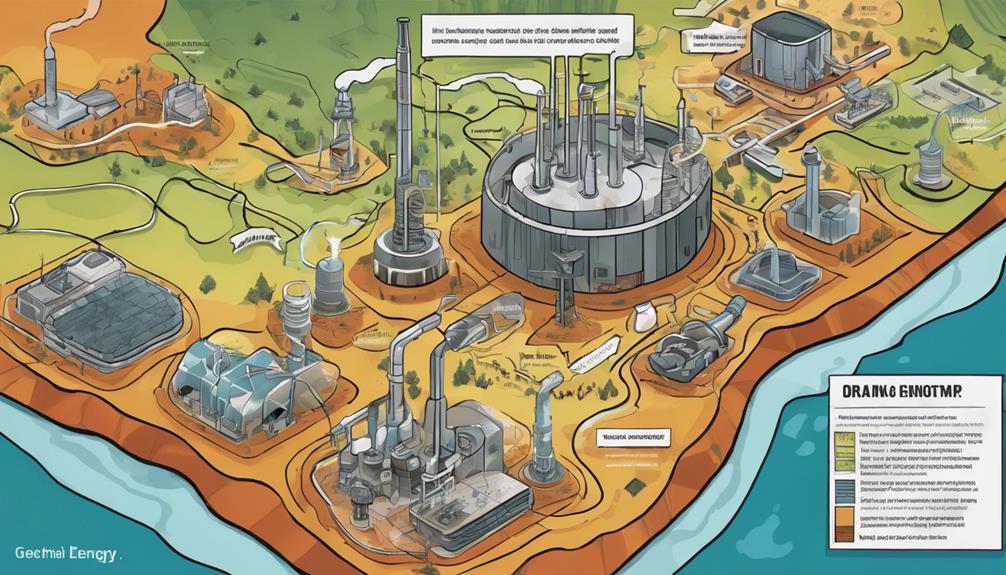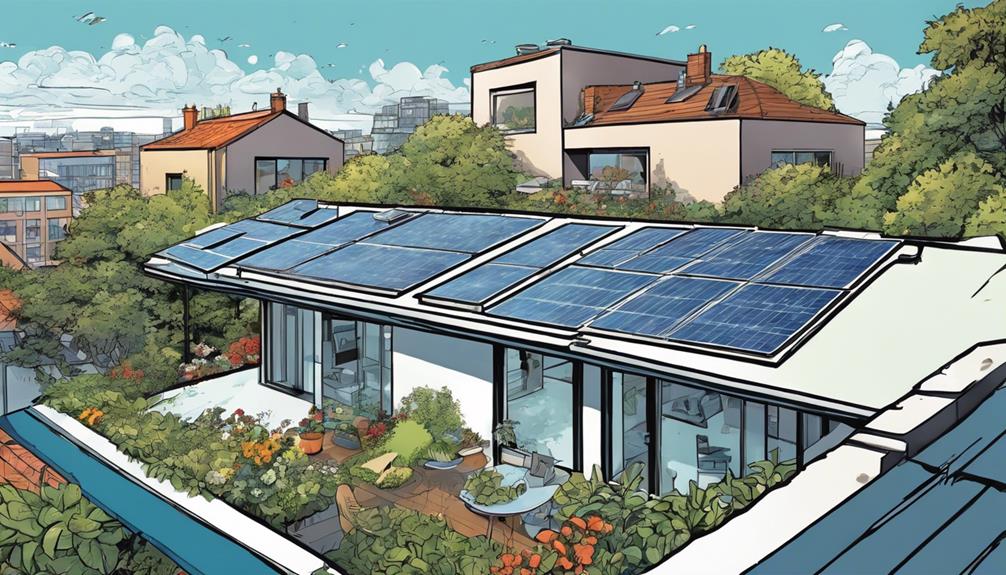Geothermal energy is currently being harnessed in various countries like the United States, El Salvador, Kenya, the Philippines, Iceland, and New Zealand. These nations are leading by using geothermal sources to generate a sizable portion of their electricity. Importantly, Costa Rica and Indonesia are also significant contributors to geothermal power production. This renewable energy form is vital in meeting the increasing global electricity demands sustainably. Discover more about geothermal energy usage, its benefits, and the challenges associated with its expansion.
Key Takeaways
- Geothermal energy is used in countries like El Salvador, Kenya, the Philippines, Iceland, and New Zealand for over 15% of electricity.
- Costa Rica is a significant producer of electricity from geothermal sources.
- Indonesia has the largest estimated potential for geothermal resources at 29 GW.
- Geothermal power contributes to meeting global electricity demands sustainably.
- Geothermal power is harnessed through various plant types like dry steam, flash steam, and binary cycle plants.
Global Geothermal Power Capacity
Global geothermal power capacity, standing at 15.4 GW in 2019, showcases a promising trend towards sustainable energy sources worldwide. The United States contributed substantially to this figure with 3.68 GW of geothermal power capacity. This capacity plays a vital role in electricity generation, with countries like El Salvador, Kenya, the Philippines, Iceland, and New Zealand already generating over 15% of their electricity from geothermal sources.
Despite this progress, predictions indicate that global geothermal power capacity could further increase to 14.5-17.6 GW by 2020, highlighting its growth potential. It's crucial to note that only 6.9% of the total global geothermal potential has been exploited, revealing noteworthy untapped geothermal energy resources.
Indonesia, in particular, stands out with the largest estimated potential of 29 GW, emphasizing its substantial geothermal capacity waiting to be harnessed for sustainable energy production.
Leading Geothermal Countries and Resources

Among the leading countries harnessing geothermal energy resources, Costa Rica stands out as a significant producer of electricity from this sustainable source. Costa Rica has made substantial investments in geothermal technologies, utilizing its geothermal capacity to generate a considerable portion of its electricity from geothermal plants.
Additionally, countries like El Salvador, Kenya, the Philippines, Iceland, and New Zealand also rely heavily on geothermal electricity, with over 15% of their energy needs being met by geothermal resources. Indonesia holds the largest estimated potential for geothermal resources globally, boasting a capacity of 29 GW.
Despite these advancements, only 6.9% of the total global geothermal potential has been harnessed so far. Geothermal energy plays a critical role in meeting the electricity demands of various nations, highlighting the importance of further exploration and utilization of geothermal resources to achieve sustainable energy solutions.
Sustainability and Environmental Impact

Considering its low carbon emissions and potential for significant global energy contributions, geothermal power stands out as a sustainable energy source with a promising future.
Geothermal power is a low-carbon energy source, emitting an average of 45 grams of CO2 per kilowatt-hour, making it environmentally friendly. Only 6.9% of the total global geothermal potential has been harnessed so far, indicating a vast opportunity for further sustainable energy development.
With the right economic incentives, geothermal power could potentially meet 3-5% of global energy demand by 2050 and up to 10% by 2100. Geothermal energy offers stability in energy production as it's immune to fuel cost fluctuations.
However, challenges like high upfront costs and water usage concerns need to be addressed for the sustainable expansion of geothermal heating and energy consumption.
Geothermal Power Station Types

When examining geothermal power station types, you'll discover a variety of technologies that harness the Earth's heat for electricity generation.
Geothermal power plants can be classified into three main types: dry steam, flash steam, and binary cycle plants.
Dry steam plants extract steam directly from underground reservoirs and use it to drive turbines for electricity production.
Flash steam plants, on the other hand, utilize high-pressure hot water from geothermal reservoirs to generate steam that powers electricity-generating turbines.
Finally, binary cycle plants operate by circulating hot water from geothermal sources to heat a secondary fluid with a lower boiling point.
This secondary fluid is vaporized and used to drive a turbine, converting heat into electricity.
Each of these geothermal power station types offers unique operational processes and efficiencies in harnessing the Earth's subsurface heat for sustainable electricity generation.
Worldwide Production and Challenges

With 14,438 MW of geothermal power online worldwide in 2020, the production of geothermal energy has made substantial strides on a global scale. Geothermal power stations require considerably less land compared to coal facilities and wind farms, highlighting their efficiency and minimal environmental impact.
Risks associated with geothermal power include land stability issues, induced seismicity, and drilling impacts, which are challenges that need to be managed. Geothermal fluids may contain trace amounts of toxic chemicals, indicating the importance of proper handling and disposal practices in geothermal energy production.
Despite facing challenges like high upfront costs and water usage concerns, geothermal energy offers benefits such as reliability, low carbon footprint, and long operational life, making it a valuable renewable energy source.
Geothermal Energy Data and Technology

You may wonder about the global geothermal capacity and how operational technology facilitates sustainable energy applications. Understanding these points can shed light on the efficiency and benefits of geothermal energy utilization.
Let's explore these aspects further to grasp the significance of geothermal data and technology in the energy sector.
Global Geothermal Capacity
One can observe a significant growth in global geothermal power capacity, which stood at 15.4 GW in 2019. This highlights the increasing utilization of geothermal resources for electricity generation worldwide.
Here are some key points to keep in mind:
- The United States contributed 3.68 GW to the global geothermal capacity in 2019.
- Indonesia possesses the largest estimated geothermal potential of 29 GW.
- Countries like El Salvador, Kenya, and the Philippines generate over 15% of their electricity from geothermal sources.
- Only 6.9% of the total global geothermal potential has been harnessed, indicating vast untapped resources.
- Geothermal power has the potential to meet 3-5% of global electricity demand by 2050 and up to 10% by 2100 with the right economic incentives.
These facts underscore the importance and potential of geothermal energy as a sustainable source of power for the future.
Operational Technology Overview
Geothermal technology plays a vital role in extracting heat from the earth's subsurface for various applications, including heating, cooling, and electricity generation.
To generate electricity, medium- or high-temperature resources close to tectonically active regions are required. Geothermal power projects have shown a Levelized Cost of Electricity (LCOE) ranging from USD 0.049 to USD 0.085 per kWh from 2010-2020.
Different operational technologies are employed in geothermal energy production, ranging from direct use to binary cycle power plants. Dry steam plants, flash plants, and binary cycle power stations are common technologies used to harness geothermal resources for electricity generation.
These technologies help efficiently convert heat from the earth into electrical power, contributing to a sustainable energy mix. Understanding these operational technologies is essential for maximizing the potential of geothermal energy and expanding its utilization in various sectors.
Sustainable Energy Applications
Sustainable energy applications of geothermal technology encompass a diverse range of innovative data-driven solutions and cutting-edge technologies.
Geothermal technology extracts heat from the Earth's subsurface for heating, cooling, or electricity, with different technologies like district heating and geothermal heat pumps in use.
Levelized Cost of Electricity (LCOE) for geothermal power projects averaged between USD 0.049 and USD 0.085 per kWh from 2010-2020, highlighting its cost-effectiveness.
Enhanced geothermal systems and binary cycle technologies are being developed to expand geothermal energy reach and efficiency.
Electricity generation from hydrothermal reservoirs has been commercialized since 1913, showcasing the maturity of geothermal power technologies.
Dry steam plants, flash plants, and binary cycle power stations harness high temperatures for power generation, each with unique operational processes and efficiencies.
Global Geothermal Alliance (GGA)

You're about to learn about the Global Geothermal Alliance (GGA) and its significant role in advancing geothermal energy worldwide.
The GGA aims to increase geothermal electricity and heat generation globally through enhanced dialogue and collaboration.
Global Geothermal Alliance Overview
IRENA coordinates the Global Geothermal Alliance (GGA) to advance worldwide geothermal electricity and heat generation. The GGA serves as a platform for global cooperation and knowledge exchange to promote the utilization of geothermal energy as a sustainable and renewable source.
Here are some key points about the Global Geothermal Alliance:
- Facilitates dialogue and knowledge sharing among countries to accelerate geothermal energy development.
- Aims to increase the share of installed geothermal electricity and heat generation globally.
- Enhances cooperation and coordinated action in expanding geothermal energy utilization.
- Advocates for geothermal energy as a sustainable and renewable energy source on a global scale.
GGA Objectives and Impact
The Global Geothermal Alliance (GGA) focuses on increasing worldwide geothermal electricity and heat generation through enhanced collaboration and knowledge sharing. The GGA's objectives include raising the share of installed geothermal electricity and heat generation globally.
By facilitating collaborative efforts, the GGA aims to promote geothermal energy as a sustainable and renewable resource. Through coordinated initiatives, countries work together to advance geothermal technologies and expand the global geothermal energy market.
IRENA plays an essential role in coordinating the GGA to enhance dialogue and knowledge sharing for synchronized geothermal energy development. The impact of the GGA is significant in driving the adoption of geothermal energy on a global scale, paving the way for increased utilization of geothermal electricity and heat generation.
The alliance's efforts are essential in harnessing the full potential of geothermal energy and promoting its growth in the renewable energy sector.
Geothermal Energy Development
With a focus on global collaboration and knowledge sharing, the Global Geothermal Alliance (GGA) plays an essential role in boosting geothermal electricity and heat generation worldwide.
- GGA is coordinated by IRENA to enhance geothermal electricity and heat generation globally.
- The alliance facilitates dialogue and knowledge exchange among countries to promote coordinated geothermal energy development.
- GGA aims to increase the proportion of geothermal electricity and heat generation installations worldwide.
- Efforts by GGA seek to advance the utilization of geothermal energy and amplify its contribution to the global energy mix.
- Through collaboration within GGA, countries work together to foster the sustainable growth of geothermal energy for electricity and heat production.
These initiatives are vital in developing geothermal power plants, expanding renewable energy sources, and promoting sustainable development practices in the energy sector.
Geothermal Power Strategy

To enhance global geothermal power generation, a strategic approach is essential for maximizing its efficiency and impact.
Geothermal power is a reliable source of electricity, with the first commercial geothermal power plant located north of San Francisco.
The development of binary cycle technology has greatly improved the efficiency of geothermal power generation.
Geothermal energy is used directly to generate electricity and provide heat, covering a substantial portion of electricity demand in various countries.
The Global Geothermal Alliance (GGA), led by IRENA, plays a pivotal role in promoting geothermal power worldwide.
Through the GGA, knowledge sharing and coordinated efforts are facilitated to increase geothermal electricity and heat generation.
Advanced technologies such as enhanced geothermal systems further drive the expansion of geothermal power.
Frequently Asked Questions
Where and How Is Geothermal Energy Used Today?
You can find geothermal energy utilized worldwide in 26 countries for electricity generation and in 70 countries for heating systems. Notable users include the United States, El Salvador, New Zealand, and Iceland, showcasing diverse applications for sustainability.
Where Is Geothermal Power Most Used?
In countries like El Salvador, Kenya, and the Philippines, geothermal power is widely utilized. These nations have harnessed the Earth's heat to generate over 15% of their electricity, showcasing the significant role geothermal energy plays in their power systems.
How Is Geothermal Energy Used on Earth?
Geothermal energy on Earth is utilized for electricity generation, heating, and agricultural purposes. It is abundant in regions with volcanic activity, offering a sustainable and reliable energy source. Geothermal energy plays an essential role in cleaner energy progressions.
What Are 10 Uses for Geothermal Energy?
Imagine discovering the versatility of geothermal energy with its ten diverse applications. From electricity generation to spa relaxation, geothermal energy powers industries, agriculture, and communities. It's a sustainable solution that benefits you in many ways.
What are the current advantages and disadvantages of using geothermal energy in different locations?
Geothermal energy plant locations offer the advantage of providing a constant, reliable source of clean, renewable energy. However, these locations can be limited to areas with suitable geothermal resources, which may not always be easily accessible. Additionally, building and maintaining geothermal energy plants can be costly and complex.
Conclusion
Now that you have learned about the current use of geothermal energy worldwide, you may be wondering what the future holds for this sustainable power source.
The potential for growth and innovation in geothermal technology is vast, with many countries already leading the way in harnessing this renewable energy.
Stay tuned for exciting developments in the world of geothermal power as we continue to work towards a greener, more sustainable future.










